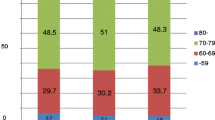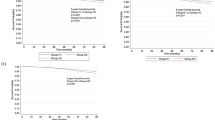Abstract
Purpose
Prostate cancer (PCa) is the most prevalent malignancy in men and the second cause of mortality in industrialized countries.
Methods
Based on Spanish Register of PCa, the incidence of high-risk PCa is 29%, approximately. In spite of the evidence-based beneficial effect of radiotherapy and androgen deprivation therapy in high-risk PCa, these patients (pts) are still a therapeutic challenge for all specialists involved, in part due to the absence of comparative studies to establish which of the present disposable treatments offer better results.
Results
Nowadays, high-risk PCa definition is not well consensual through the published oncology guides. Clinical stage, tumour grade, and number of risk factors are relevant to be considered on PCa prognosis. However, these factors are susceptible to change depending on when surgical or radiation therapy is considered to be the treatment of choice. Other factors, such as reference pathologist, different diagnosis biopsy schedules, surgical or radiotherapy techniques, adjuvant treatments, biochemical failures, and follow-up, make it difficult to compare the results between different therapeutic options.
Conclusions
This article reviews important issues concerning high-risk PCa. URONCOR, GUO, and SOGUG on behalf of the Spanish Groups of Uro-Oncology Societies have reached a consensus addressing a practical recommendation on definition, diagnosis, and management of high-risk PCa.

Similar content being viewed by others
References
Siegel R, Naishadham D, Jemal A. Cancer statistics, 2013. CA Cancer J Clin. 2013;63:11–30.
Cooperberg MR, Broering JM, Carroll PR. Time trends and local variation in primary treatment of localized prostate cancer. J Clin Oncol. 2010;28(7):1117–23.
Van Hemelrijck M, Folkvaljon Y, Adolfsson J, Akre O, Holmberg L, Garmo H, et al. Causes of death in men with localized prostate cancer: a nationwide, population-based study. BJU Int. 2016;117(3):507–14.
Cózar JM, Miñana B, Gomez Veiga F, Rodríguez Antolín A, Villavicencio H, et al. Prostate cancer incidence and newly diagnosed patients profile in Spain in 2010. BJU Int. 2012;110(11):701–6.
Boorjian SA, Karnes RJ, Viterbo R, Rangel LJ, Bergstralh EJ, Horwitz EM, et al. Long-term survival after radical prostatectomy versus external-beam radiotherapy for patients with high-risk prostate cancer. Cancer. 2011;117(13):2883–91.
Briganti A, Joniau S, Gontero P, Abdollah F, Passoni NM, Tombal B, et al. Identifying the best candidate for radical prostatectomy among patients with high-risk prostate cancer. Eur Urol. 2012;61(3):584–92.
Joniau S, Briganti A, Gontero P, Gandaglia G, Tosco L, Fieuws S, et al. Stratification of high-risk prostate cancer into prognostic categories: a European multi-institutional study. Eur Urol. 2015;67(1):157–64.
Mohler JL, Armstrong AJ, Bahnson RR, D’Amico AV, Davis BJ, Eastham JA, et al. NCCN clinical practice guidelines in oncology (NCCN guidelines®). Prostate Cancer. Version 1.2016. J Natl Compr Canc Netw. 2016;14(1):19–30.
Mottet N, BellmuntJ Bolla M, Briers E, Cumberbatch MG, De Santis M, et al. EAU-ESTRO-SIOG Guidelines on prostate cancer. Part I: screening, diagnosis, and local treatment with curative intent. Eur Urol. 2016;71:618–29.
Cózar JM, Solsona E, Morote J, Miñana B, Maroto JP, González Del Alba A, et al. Recomendaciones sobre el manejo de controversias en cáncer de próstata avanzado resistente a la castración. Actas Urol Esp. 2012;36(10):569–77.
Thompson I, Brantley Thrasher J, Aus G, Burnett AL, Canby-Hagino ED, et al. Guideline for the management of clinically localized prostate cancer. AUA Prostate Cancer Guideline. Version 1. 2016. (AUA guidelines®). http://www.auanet.org/education/guidelines/. Accessed Oct 2016.
American Society for Radiation Oncology (ASTRO) guidelines on prostate cancer. Prostate Cancer Guideline. http://www.astro.org. Accessed Nov 2016.
Cornford P, Bellmunt J, Bolla M, Briers E, De Santis M, GrossT, et al. EAU-ESTRO-SIOG Guidelines on prostate cancer. Part II: treatment of relapsing, metastatic, and castration-resistant prostate cancer. Ann Oncol 2015. http://uroweb.org/guideline/prostate-cancer/ (Eur Urol 2016).
American Society of Clinical Oncology (ASCO) guidelines on prostata cancer. Prostate cancer guidelines. http://www.asco.org. Accessed Nov 2016.
Parker C, Gillessen S, Heidenreich A, Horwich A. Cancer of the prostate: ESMO clinical practice guidelines for diagnosis, treatment and follow-up. Ann Oncol. 2015;5(Suppl 5):S69–77. doi:10.1093/annonc/mdv222.
Higgins JP, Altman DG, Gotzsche PC, Jüni P, Moher D, Oxman AD, et al. The Cochrane collaboration’s tool for assessing risk of bias in randomised trials. BMJ. 2011;343:d5928.
Perera M, Papa N, Christidis D, Wetherell D, Hofman MS, Murphy DG, et al. Sensitivity, specificity, and predictors of positive 68 Ga-prostate-specific membrane antigen positron emission tomography in Advanced prostate cancer: a systematic review and meta-analysis. Eur Urol. 2016;70:926–37.
Fossa SD, Wiklund F, Klepp O, Angelsen A, Solberg A, Damber JE, et al. Ten and 15 yr prostate cancer-specific mortality in patients with nonmetastatic locally advanced or aggressive intermediate prostate cancer, randomized to lifelong endocrine treatment alone or combined with radiotherapy: final results of the Scandinavian Prostate Cancer Group 7. Eur Urol. 2016;70:684–91.
Mason MD, Parulekar WR, Sydes MR, Brundage M, Kirkbride P, Gospodarowicz M, et al. Final report of the Intergroup randomized study of combined androgen-deprivation therapy plus radiotherapy versus androgen-deprivation therapy alone in locally advanced prostate cancer. J Clin Oncol. 2015;33:2143–50.
Mottet N, Peneau M, Mazeron JJ, Molinie V, Richaud P. Addition of radiotherapy to long-term androgen deprivation in locally advanced prostate cancer: an open randomised phase 3 trial. Eur Urol. 2012;62:213–9.
Bolla M, Van Tienhoven G, Warde P, Dubois JB, Mirimanoff RO, Storme G, Bernier J, et al. External irradiation with or without long-term androgen suppression for prostate cancer with high metastatic risk: 10-year results of an EORTC randomised study. Lancet Oncol. 2010;11:1066–73.
Zapatero A, Guerrero A, Maldonado X, Alvarez A, Gonzalez SanSegundo C, Cabeza Rodríguez MA, et al. High-dose radiotherapy with short-term or long-term androgen deprivation in localized prostate cancer (DART01/05 GICOR): a randomised, controlled, phase 3 trial. Lancet Oncol. 2015;16:320–7.
Creak A, Hall E, Horwich A, Eeles R, Khoo V, Huddart R, et al. Randomised pilot study of dose escalation using conformal radiotherapy in prostate cancer: long-term follow-up. Br J Cancer. 2013;109:651–7.
Kuban DA, Tucker SL, Dong L, Starkschall G, Huang EH, Cheung MR, et al. Long-term results of the MD Anderson randomized dose-escalation trial for prostate cancer. Int J Radiat Oncol Biol Phys. 2008;70:67–74.
Zietman AL, Bae K, Slater JD, Shipley WU, Efstathiou JA, Coen JJ, et al. Randomized trial comparing conventional-dose with high-dose conformal radiation therapy in early-stage adenocarcinoma of the prostate: long-term results from Proton Radiation Oncology Group/American College of Radiology 95-09. J Clin Oncol. 2010;28:1106–11.
Heemsbergen WD, Al-Mamgani A, Slot A, Dielwart MF, Lebesque JV. Long-term results of the Dutch randomized prostate cancer trial: impact of dose-escalation on local, biochemical, clinical failure, and survival. Radiother Oncol. 2014;110:104–9.
Beckendorf V, Guerif S, Le Prise E, Cosset JM, Bougnoux A, Chauvet B, et al. 70 Gy versus 80 Gy in localized prostate cancer: 5-year results of GETUG 06 randomized trial. Int J Radiat Oncol Biol Phys. 2011;80:1056–63.
Dearnaley DP, Jovic G, Syindikus I, Khoo V, Cowan RA, Graham JD, et al. Escalated-dose versus control-dose conformal radiotherapy for prostate cancer: long-term results from the MRC RT01 randomised controlled trial. Lancet Oncol. 2014;15:464–73.
Zaorsky NG, Palmer JD, Hurwitz MD, Keith SW, Dicker AP, Den RB. What is the ideal radiotherapy dose to treat prostate cancer? A meta-analysis of biologically equivalent dose escalation. Radiother Oncol. 2015;115:295–300.
Mitchell CR, Boorjian SA, Umbreit EC, Rangel LJ, Carlson RE, Karnes RJ. 20-year survival after radical prostatectomy as initial treatment for cT3 prostate cancer. BJU Int. 2012;110(11):1709–13.
Briganti A, Spahn M, Joniau S, Gontero P, Bianchi M, Kneitz B, European Multicenter Prostate Cancer Clinical and Translational Research Group (EMPaCT), et al. Impact of age and comorbidities on long-term survival of patients with high-risk prostate cancer treated with radical prostatectomy: a multi-institutional competing-risks analysis. Eur Urol. 2013;63(4):693–701.
Lanchon C, Shariat SF, Roupret M. The role for surgery in high-risk prostate cancer. Wien MEd Wocheschr. 2015;165:395–400.
Boorjian SA, Karnes RJ, Rangel LJ, Bergstralh EJ, Frank I, Blute ML. Impact of prostate-specific antigen testing on the clinical and pathological outcomes after radical prostatectomy for Gleason 8–10 cancers. BJU Int. 2008;101:299–304.
Morton GC. High-dose-rate brachytherapy boost for prostate cancer: rationale and technique. J Contemp Brachytherapy. 2014;6:323–30.
Martinez AA, Gonzalez J, Ye H, Ghilezan M, Shetty S, Kernen K, et al. Dose escalation improves cancer-related events at 10 years for intermediate- and high-risk prostate cancer patients treated with hypofractionationated high-dose-rate boost and external beam radiotherapy. Int J Rad Oncol Biol Phys. 2011;79:363–70.
Boladeras A, Santorsa L, Gutierrez C, Martinez E, Pera J, Pino F, et al. External radiotherapy plus single-fraction high dose rate brachytherapy in the treatment of locally advanced prostate cancer. Radiother Oncol. 2014;112:227–32.
Sathya JR, Davis IR, Julian JA, Guo Q, Daya D, Dayes IS, et al. Randomized trial comparing iridium implant plus external-beam radiation therapy with external-beam radiation therapy alone in node-negative locally advanced cancer of the prostate. J Clin Oncol. 2005;23:1192–9.
Hoskin PJ, Rojas AM, Bownes PJ, Lowe GJ, Ostler PJ, Bryant L, et al. Randomised trial of external beam radiotherapy alone or combined with high-dose-rate brachytherapy boost for localised prostate cancer. Radiother Oncol. 2012;103:217–22.
Morris WJ, Tydesley S, Rodda S, Halperin R, Pai H, McKenzie M, et al. ASCENDE-RT: an analysis of survival endpoints for a randomized trial comparing a low-dose-rate brachytherapy boost to a dose-escalated external beam boost for high-and intermediate-risk prostate cancer. Int J Radiat Oncol Biol Phys. 2016;. doi:10.1016/j.ijrobp.2016.11.026.
Parsons JK, Messer K, Palazzi K, Stroup S, Chang S. Diffusion of surgical innovations, patient safety, and minimally invasive radical prostatectomy. JAMA Surg. 2014;149(8):845–51.
Carlsson S, Berglund A, Sjoberg D, Khatami A, Stranne J, Bergdahl S, et al. Effects of surgeon variability on oncologic and functional outcomes in a population-based setting. BMC Urol. 2014;14:25.
Vale CL, Burdett S, Rydzewska LHM, Albiges L, Clarke NW, Fisher D, et al. Addition of docetaxel or bisphosphonates to standard of care in men with localised or metastatic, hormone-sensitive prostate cancer: a systematic review and meta-analyses of aggregate data. Lancet Oncol. 2016;17:243–56.
Vickers A, Savage C, Bianco F, Mulhall J, Sandhu J, Guillonneau B, et al. Cancer control and functional outcomes after radical prostatectomy as markers of surgical quality: analysis of heterogeneity between surgeons at a single cancer center. Eur Urol. 2011;59(3):317–22.
Miller DC, Birkmeyer JD. Moving beyond the headlines: improving the technical quality of radical prostatectomy. Eur Urol. 2014;65(6):1020–2.
Wang EH, Yu JB, Gross CP, Abouassaly R, Cherullo EE, Smaldone MC, et al. Association between surgeon and hospital characteristics and lymph node counts from radical prostatectomy and pelvic lymph node dissection. Urology. 2015;85(4):890–5.
Wilt TJ, Shamliyan TA, Taylor BC, MacDonald R, Kane RL. Association between hospital and surgeon radical prostatectomy volume and patient outcomes: a systematic review. J Urol. 2008;180(3):820–8.
Trinh QD, Bjartell A, Freedland SJ, Hollenbeck BK, Hu JC, Shariat SF, et al. A systematic review of the volume-outcome relationship for radical prostatectomy. Eur Urol. 2013;64(5):786–98.
Eden CG, Zacharakis E, Bott S. The learning curve for laparoscopic extended pelvic lymphadenectomy for intermediate- and high-risk prostate cancer: implications for compliance with existing guidelines. BJU Int. 2013;112(3):346–54.
Cathcart P, Sridhara A, Ramachandran N, Briggs T, Nathan S, Kelly J. Achieving quality assurance of prostate cancer surgery during reorganisation of cancer services. Eur Urol. 2015;68(1):22–9.
Author information
Authors and Affiliations
Corresponding author
Ethics declarations
Conflict of interest
The authors declare that they have no conflict of interest.
Research involving human participants and/or animals
Not applicable.
Informed consent
Not applicable.
Funding
No funding to declare.
Rights and permissions
About this article
Cite this article
Henríquez, I., Rodríguez-Antolín, A., Cassinello, J. et al. Consensus statement on definition, diagnosis, and management of high-risk prostate cancer patients on behalf of the Spanish Groups of Uro-Oncology Societies URONCOR, GUO, and SOGUG. Clin Transl Oncol 20, 392–401 (2018). https://doi.org/10.1007/s12094-017-1726-y
Received:
Accepted:
Published:
Issue Date:
DOI: https://doi.org/10.1007/s12094-017-1726-y




